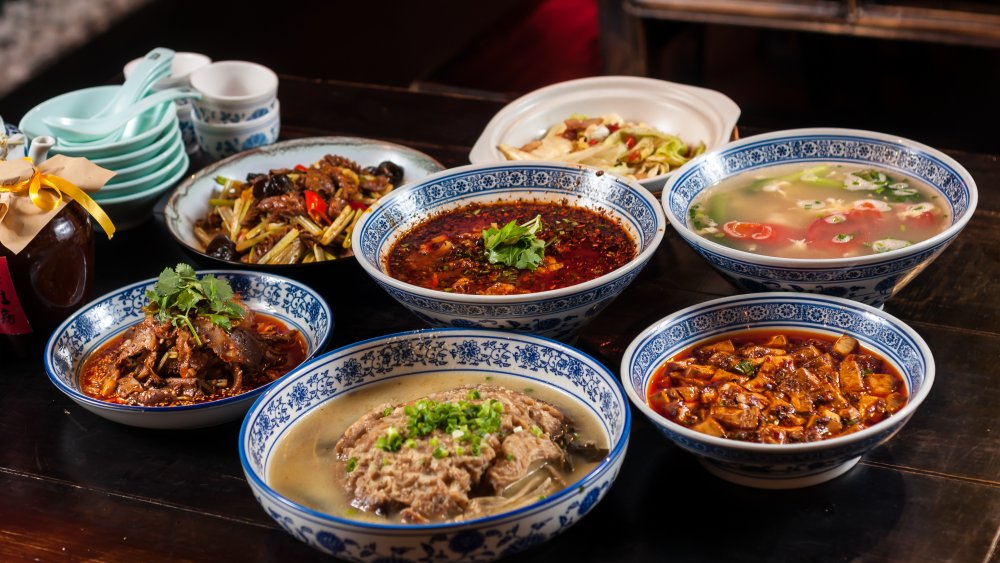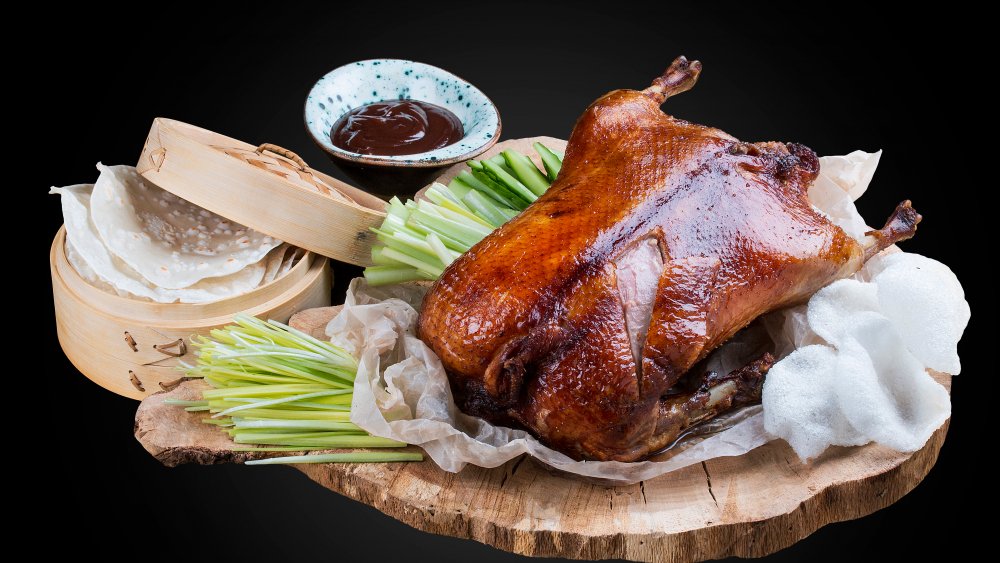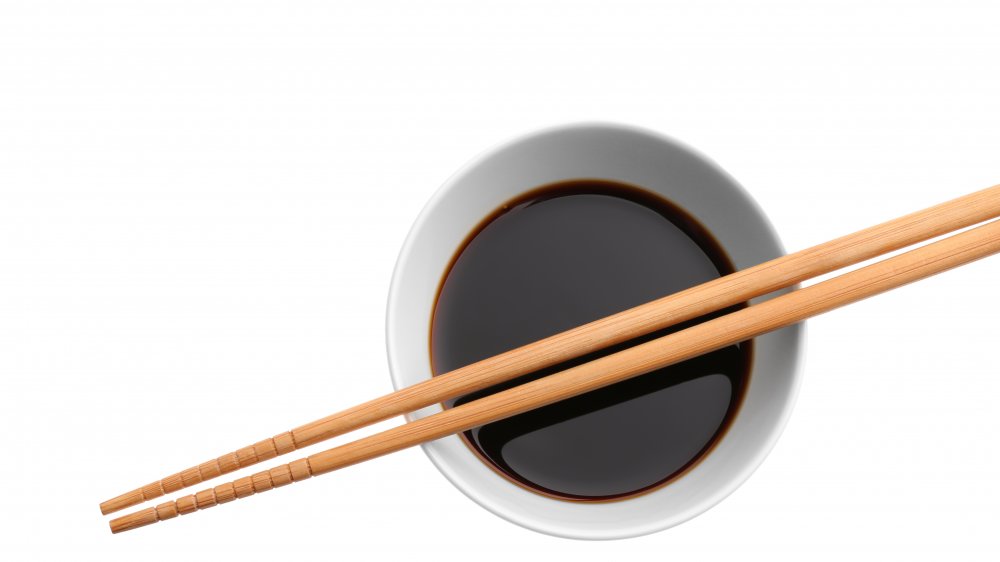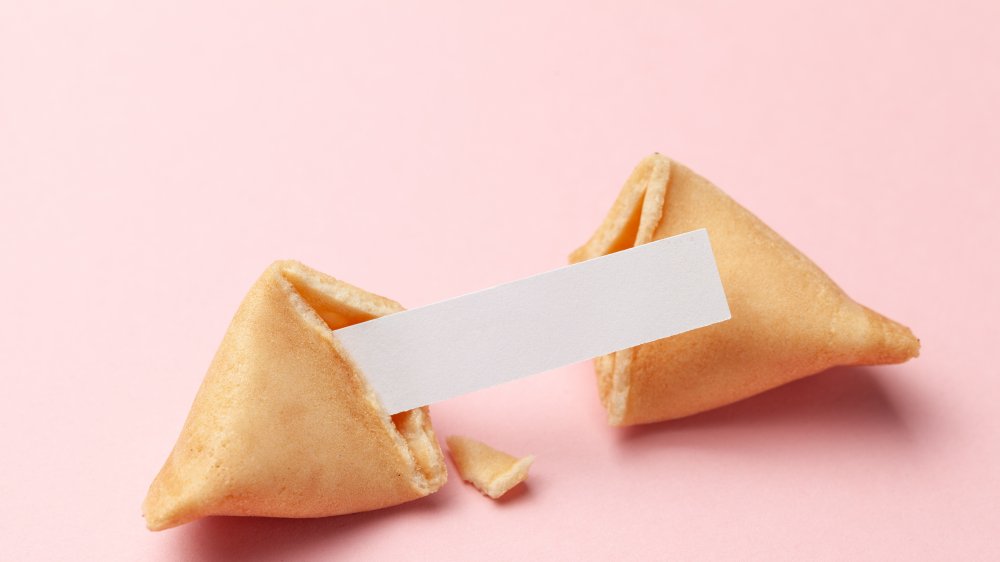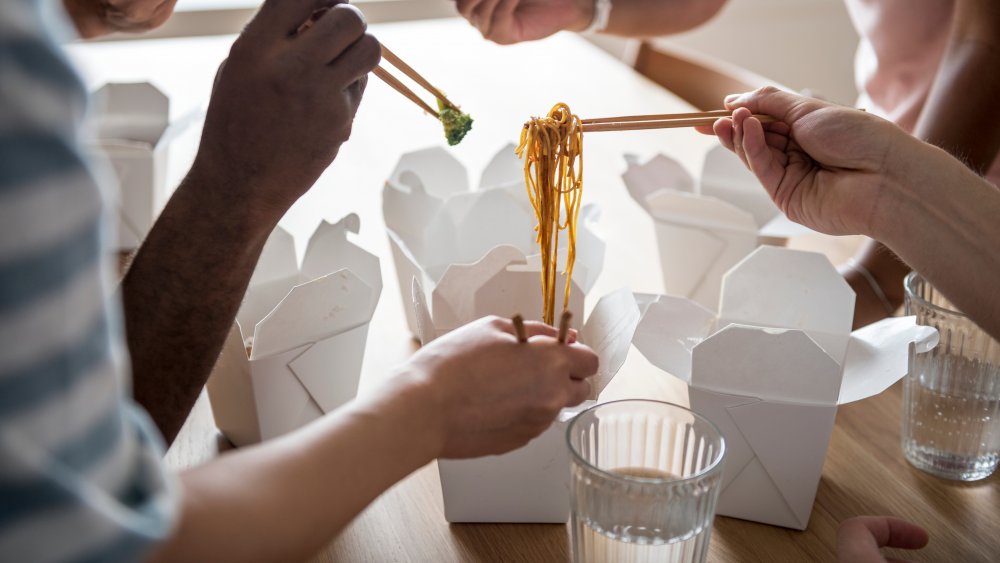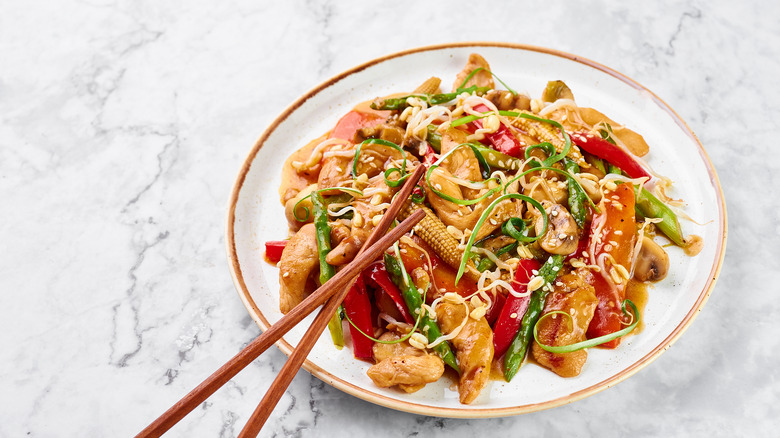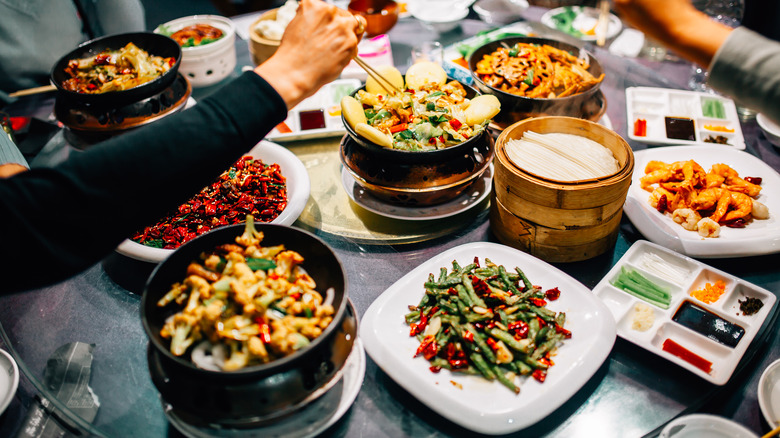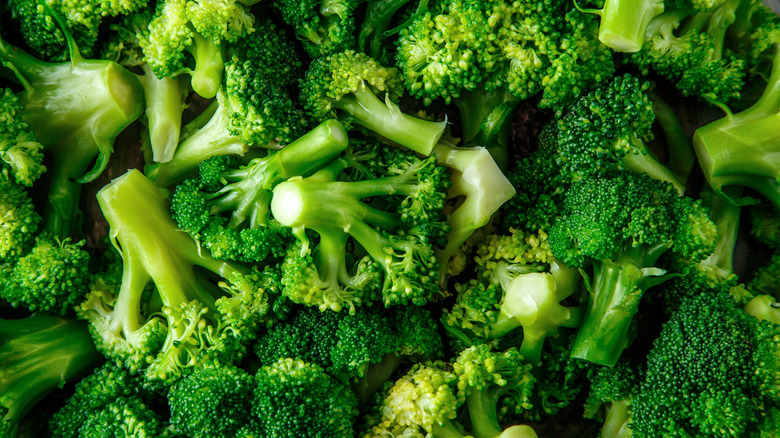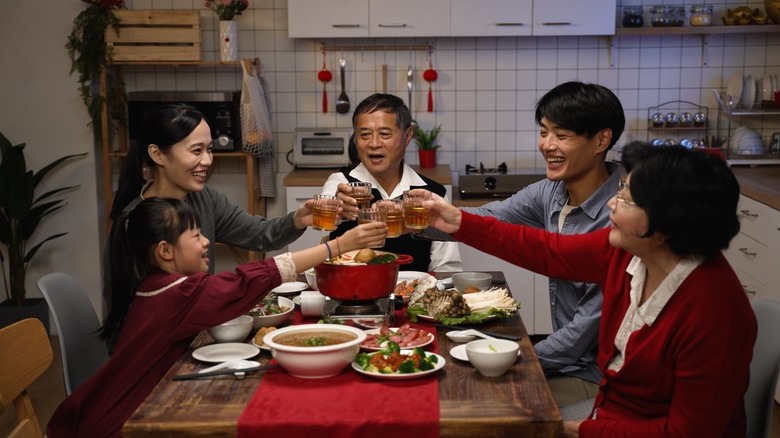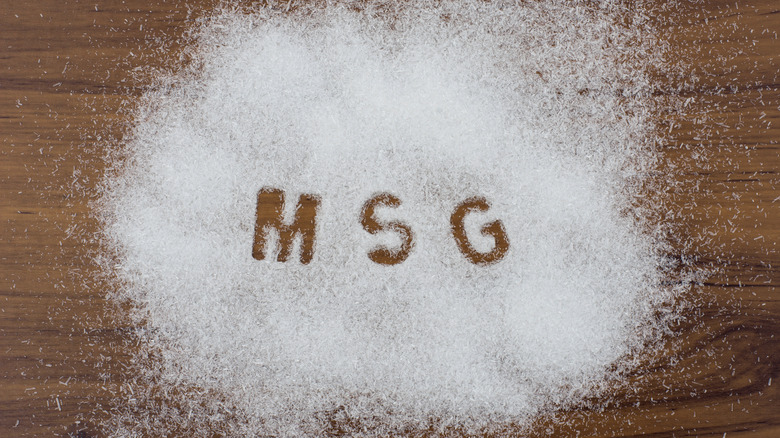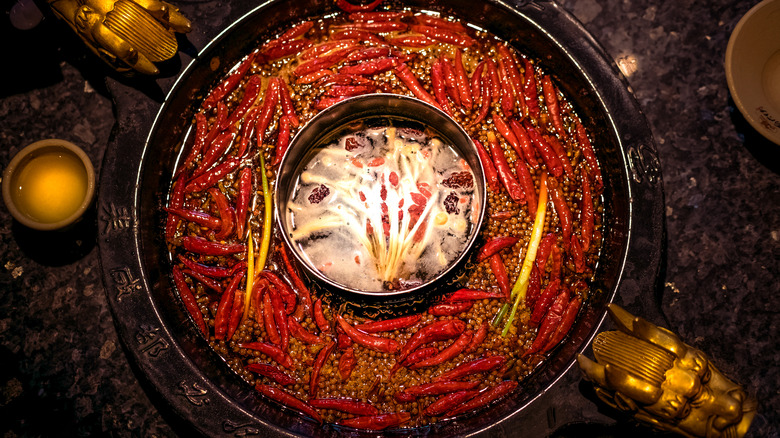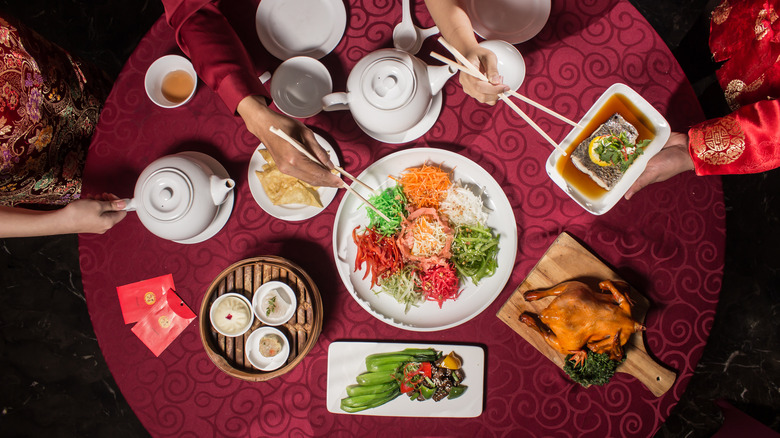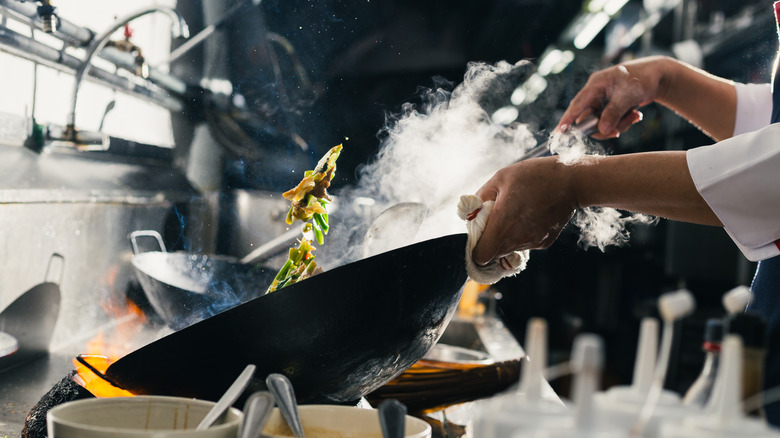Myths About Chinese Food You Should Stop Believing
If you or your family ever lived near a Chinese restaurant, you'd probably just have assumed that whatever it was you were ordering, be it chow mein or lo mein, General Tso's chicken, egg rolls, or chop suey, was the real deal. But what if we told you that what you thought were popular dishes in Chinese cooking are in fact less Chinese and more American, and which had been adapted to suit American tastes? And that these adaptations, per Jennifer 8. Lee in her TED Talk, actually introduced ingredients into Chinese American cuisine that weren't actually native to China — like broccoli (of the hit duo "beef and broccoli")?
Because Chinese cooking in America has been exceedingly adaptable, many myths surrounding the cuisine have become accepted as fact — and these myths might easily be debunked after just one trip to an authentic Chinese restaurant. Here are just a few.
All Chinese food is stir fried
Chinese-American cooking may be all about the stir fry, but there are different ways to get food ready to suit the tastes of a discriminating crowd. Tofu, seafood like shrimp or squid, and pieces of chicken can be breaded and deep-fried in hot vats of oil so they are made crisp and flavorful with a few shakes of salt and pepper.
Xiaolongbao and dim sum are small bites which are steamed in artful little bamboo baskets before they are served. Tough meats are "red stewed" or cooked in a clay pot over a very low flame for hours in a sauce with soy sauce, sugar, wine, ginger, five spice powder, chili, and cilantro. Hotpots are boiling soups into which vegetables, noodles, and pieces of meat are cooked quickly before they are dipped in sauces and consumed. And then there are the roasts which include ducks, geese, and pork which feature crisp, seared skin which crackle when cut, and which gives way to tender, flavorful meats just beneath (via China Highlights).
All Chinese dishes require soy sauce
The world of Chinese cooking is vast. So vast that it encompasses at least eight different regional cuisines including Cantonese, Szechuan, Zhejiang, Fujian, Hunan, and Shandong. Some of these cuisines like their soy sauce, others embrace chilies and specialty peppercorns that numb the mouth (via China Highlights).
This may explain why, although soy sauce is a popular condiment, it isn't exactly at the center of the cooking universe that is Chinese cuisine. Instead, it shares the limelight with vinegar, cooking wine, chili sauces, and soybean paste. Daxue Consulting notes that while Chinese diners do enjoy salty foods, spicy reigns supreme; and when special diets take spicy condiments out of the flavor equation, soybean pastes and tahini come in second and third, respectively.
Fortune cookies are Chinese
The history of America's favorite Chinese dessert was uncovered by Jennifer 8. Lee as she was writing her book The Fortune Cookie Chronicles. Lee had the chance to speak with Yasuko Nakamichi, a food scholar who spent a considerable amount of time trying to trace the history of the fortune cookie. Nakamichi thinks the cookies are inspired by a Kyoto (Japan) pastry called the tsujiura senbei (fortune cookie) or omikuji senbei (written fortune crackers).
But unlike their American cousins, the Japanese versions of the cookie are flavored with miso, and their messages are written on the outside of the pastry, instead of on the inside on a sheet of paper. Japanese baker Benkyodo was the main supplier of fortune cookies until World War II forced Japanese Americans into internment camps, at which point the Chinese Americans began making their own fortune cookies — and the rest is history. Today, Eat This, Not That! says the biggest manufacturer of fortune cookies is Wonton Food, which makes 4 million fortune cookies a day.
Those white takeout food cartons are common in China
If you go to a Chinese restaurant in Asia, don't be surprised if your takeout comes to you in a plastic bag or packed into a nondescript box where a lid is held in place with rubber bands. The genesis of what we think is an awesome takeout box was the brainchild of American inventor Frederick Weeks Wilcox who took a patent in 1894, for what he called a "paper pail."
Inspired by existing oyster pails of his time, Wilcox's brainchild was made with a single sheet of paper, creased into segments and folded into a nearly-leakproof container with a delicate wire handle (via The New York Times). One of the producers for this cool container was a company named Fold-Pak, which, in the 1970s, had a graphic designer who went on to add a pagoda and "Thank you" in what was meant to look like Chinese calligraphy, both printed in red (via Reader's Digest). For what it's worth, Fold-Pak doesn't remember who that graphic designer is, but the company knows one thing — it doesn't sell the takeout boxes in China.
Chinese food is the same in China and the US
Chinese food in the U.S. has evolved since first appearing in the 19th century, per Vice. Rather than displaying traditional flavors, Chinese cuisine has been adapted to suit American tastes. Case in point, chop suey restaurants made their debut in the U.S. at the turn of the 20th century. Translated as odds and ends, the meat, egg, and vegetable dish has little to do with authentic Chinese cuisine (via Time). In fact, New York Times writer Jennifer 8. Lee highlighted in her 2008 TED talk that most Chinese people don't even know about chop suey.
Many dishes served at Chinese restaurants in the U.S. are American inventions. General Tso's chicken is a prime example. The boneless chicken dish was invented by Hunan chef Peng Chang-Kuei who cooked it for a visiting American Navy Seal in Taiwan in 1952. After emigrating to America in 1973, Peng opened a restaurant where he altered the dish to American tastes by including sugar in the sauce (via Rasa Malaysia).
Another popular Chinese-American creation you're unlikely to be served in China is orange chicken. This is because it was invented by chef Andy Kao for the opening of a new Panda Express outlet in Hawaii in 1987 (via Resy). The sticky meal pairs citrusy notes with sweet and sour elements typical of Yangzhou, the hometown of Panda Express' co-founder Andrew Cherng.
Restaurant menus in China are as extensive as their American counterparts
If you've ever eaten at an American-style Chinese restaurant, you've probably come across a multipage menu, complete with dish descriptions and photos. While Chinese restaurant menus in the U.S. may seem huge, appearances can be deceiving. As pointed out by a Reddit member, many of the dishes simply contain a mix of the same ingredients in different formulations.
While some diners enjoy the large selection, others aren't so impressed. In his article for the HuffPost, Joe Satran bemoaned the fact that it took him three tries to eat a decent meal at a Sichuan restaurant in Manhattan simply because there were 218 items on the menu. "No one kitchen can make 218 different dishes, or even 118 items, equally well," he wrote. "So why not, to use a culinary analogy beloved by editors, trim away the fat, leaving a much shorter menu brimming with, say, 30 or 40 fantastic dishes?"
To cater to both American and Chinese tastes, some Chinese restaurants actually have two different menus. If you want to avoid looking through pages of American-style Chinese dishes, it may be a good idea to inquire about this secret menu. In an article for Reader's Digest, Sarah Madaus writes that anyone in search of a more authentic Chinese dining experience should find restaurants with Chinese customers, communal rice dishes, and fish tanks with live seafood.
Broccoli appears in traditional Chinese cooking
Broccoli makes an appearance in a number of Chinese dishes, most notably beef and broccoli. And while broccoli is a healthy addition to any meal, the cruciferous vegetable is by no means a part of traditional Chinese cuisine. In fact, broccoli isn't even native to the Asian country (via China Highlights). Instead, broccoli comes from the Mediterranean and was first commercially cultivated in the 16th century (via The Spruce Eats). While president Thomas Jefferson is said to have brought seeds to the U.S. from Italy in the 1700s, the vegetable didn't become popular until the early 1900s.
China has its own type of broccoli called kai-lan, gai-lan, or Chinese kale. The vegetable has a thick stem, flat leaves, and small florets (via Eater). The broad leaves have a bitter and somewhat spicy flavor. In the kitchen, Chinese broccoli is usually blanched and stir-fried (via New Entry). It can also be boiled or used fresh in salads. Plus, the versatile vegetable is a great source of iron, calcium, iron, and vitamins A, C, and E.
There's one common Chinese cuisine
Chinese cuisine is far from uniform which shouldn't come as a surprise since the country occupies around 3,700,000 square miles (via World Atlas). In fact, China boasts eight popularly recognized culinary styles: Cantonese, Anhui, Fujian, Jiangsu, Hunan, Szechuan, Shandong, and Zhejiang (via Hakkasan). The cuisines come from different regions of the country, each with distinct geographic, environmental, and historical characteristics.
The most internationally recognized style of Chinese cuisine is Cantonese food from Guangdong. This is because most of the Chinese immigrants first coming to the U.S. hailed from the province and brought the culinary style along with them. The situation changed in the '60s and '70s with the easing of American immigration policy. Migrants — and their culinary traditions — came from mainland China, Taiwan, and Hong Kong, per Time. According to the outlet, in 2016 there were over 45,000 Chinese restaurants in the U.S. — more than the sum of McDonald's, KFCs, Pizza Huts, Taco Bells, and Wendy's outlets — representing different styles of the country's cooking.
MSG in Chinese food is bad for you
Over the years, MSG (monosodium glutamate) has received some rather bad press. The additive used to enhance the umami flavor of food has been blamed for all sorts of ailments including headaches, numbness, and heart palpitations (via CNN). Unfortunately, it has also become associated with Chinese restaurants. The Merriam-Webster Dictionary even features an entry for the term Chinese restaurant syndrome, a collection of symptoms that purportedly affect some people who consume food seasoned with MSG. Never mind the fact that MSG appears in many non-Chinese products such as Doritos (via Inverse).
There's absolutely no evidence to link MSG with negative health effects. The U.S. Food & Drug Administration organized an independent inquiry into the substance in the '90s and classified MSG as "generally recognized as safe" in food. So what's triggered the misinformation? The issue started to be debated after pediatrician Dr. Ho Man Kwok wrote a letter complaining of numbness after eating American Chinese food. The letter was published in the New England Journal of Medicine in 1968 and pointed to MSG as the culprit (per Inverse). Despite the lack of credible evidence, the idea was supported by some medical professionals and over the years has been afforded a degree of legitimacy.
Chinese dishes are always spicy
With eight regional cuisines, Chinese food has many different flavor profiles. And while some dishes are indeed spicy, this definitely doesn't apply across the board. In fact, the most internationally popular Chinese cuisine isn't spicy. Instead, Cantonese food from Guangdong is characterized by an abundance of seafood and moderate use of spices. Other regions that feature relatively mild flavors include Fujian, Anhui, Jiangsu, Shandong, and Zhejiang (via Hakkasan).
This isn't to say that Chinese food can't be spicy. In particular, Hunan and Sichuan foods are known for their chili pepper kick. Infused with Sichuan peppercorns, Sichuan cuisine is famous for its effect on the tongue — some have equated it to tingling, and others describe it as an electric current. Hunan cuisine is touted as being even hotter than its Sichuan counterpart (via Silky Kitchen). Arguably one of the fieriest Hunan dishes is white pepper smoked beef, which combines dried meat, egg, tofu, scallions, and crushed white pepper (via Foodeiz).
The dishes are always greasy
While some Chinese dishes use generous amounts of oil, this is by no means the case for all. The cuisine is extremely varied and many meals include light stir-fries, steamed, boiled, and baked preparations, as well as some oilier foods. In addition, most Chinese feasts come with rice and vegetables which aren't inherently fatty (via Fuchsia Dunlop).
Even if some Chinese food may appear oily, this is for a good reason. According to Fuchsia Dunlop, Chinese cuisine uses oil rather than sauce as a medium for flavors. Consequently, it is not meant to be ingested in large amounts. If you use chopsticks to eat your food, you are likely to leave most of the oil behind. Unfortunately, many Westerners who aren't chopstick literate end up eating Chinese food with a spoon and fork, which means that they consume more oil than desired (via Chinese Foods Recipe).
Chinese cuisine is cheap
In the U.S., there is a misconception that Chinese food is cheap. However, this isn't the case in many other countries. In Japan, for instance, Chinese food is considered haute cuisine. Meanwhile, in China, restaurants range from cheap hole-in-the-wall joints to elegant establishments that deliver a five-star dining experience (via Thought Catalog). Even in the U.S., a number of Chinese restaurants cost a pretty penny (via HuffPost).
So why is Chinese food often perceived as cheap? Krishnendu Ray, an associate professor of food studies, tells The Atlantic that it's due to a "global hierarchy of taste." To sum up his idea, the wealthier and more powerful the immigrants from a certain country are viewed to be, the more prestigious — and by extension, expensive — their cuisine. "With China, [Americans] are still filled with this funny disdain, that it is [...] about cheap and crappy food," Ray says.
Jing Gao, founder of the condiment company Fly by Jing, agrees with this notion. According to her, Chinese food commanded such low prices in the U.S. in the 19th century primarily because staff in restaurants were paid abysmally. "Real food, real ingredients, ethical sourcing, and manufacturing come at a cost. Our food, our culture, and our people have value, and it's about time our compensation reflects that," she wrote in an article for Food & Wine.
